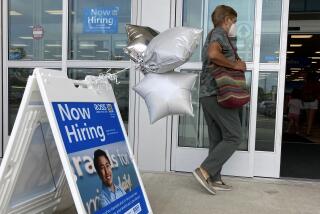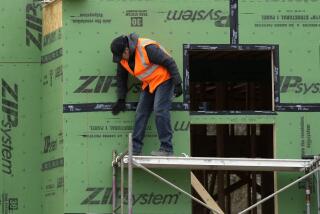Factory sector contracts; jobless claims up
NEW YORK — U.S. manufacturing contracted for a third straight month in April while the number of workers claiming jobless benefits hit a four-year high and planned layoffs soared, according to data Thursday that showed the economy remained on shaky ground.
Other data showed that personal spending in March was stronger than expected -- a bit of good news in an economy that is largely fueled by consumer spending -- but inflation pressures increased.
The manufacturing news, released by the Institute for Supply Management, was marginally better than expected, though it was still the fourth time in five months that the index showed manufacturing contracting.
“It looks like we came in slightly above expectations, so this number is consistent with positive growth in the economy,” said Michael Darda, chief economist at MKM Partners in Greenwich, Conn.
“This is a very sharp slowdown, and it’s possible we’ll have a recession, but if it doesn’t happen in the next quarter, it won’t happen. The idea that it is a deep and long collapse is just flatly incorrect. There’s no evidence of that.”
The Institute for Supply Management said its index of national factory activity was unchanged in April from March at 48.6. That was better than economists’ median forecast for a result of 48.0, according to a Reuters poll, but still below the level of 50 that separates growth from contraction.
The institute’s gauge of inflation was at its highest since May 2004, highlighting the dilemma of slow growth and strong price pressures facing the economy.
The number of workers remaining on jobless benefits jumped to a bigger-than-expected 3.019 million in the week that ended April 19, the Labor Department said. That was the highest level since April 2004.
Initial claims for jobless benefits increased more than expected to 380,000 in the week that ended April 26, from a slightly upwardly revised 345,000 the previous week.
Adding to the gloomy job picture, a report from the Chicago-based outplacement firm Challenger, Gray & Christmas Inc. showed that planned job cuts by U.S. companies rose 68% in April from the previous month to a 19-month high.
U.S. construction spending fell a steeper-than-expected 1.1% in March after the previous month was revised sharply higher, a Commerce Department report showed, with private home building suffering a record decline.
A separate release from the Commerce Department showed that U.S. personal spending rose by 0.4% in March, twice as much as forecast, while a key inflation measure was up by a bit more than expected.
Economists polled by Reuters had forecast that personal spending would rise 0.2%, compared with a 0.1% gain the previous month as the U.S. housing crisis chilled economic activity and pinched consumers.
The Commerce Department said personal income was up 0.3% in March, slightly less than forecasts for a 0.4% rise and after a 0.5% February gain. But adjusted for inflation, income stagnated after increasing by 0.3% in February.
The overall personal consumption expenditures price index, which measures the price pressures faced by consumers, rose 0.3% in March from a 0.1% increase the month before.
Excluding volatile food and energy prices, the core price index, which is the Federal Reserve’s preferred measure of inflation, was up 0.2% versus forecasts for a 0.1% rise. That followed a 0.1% gain in February.
More to Read
Inside the business of entertainment
The Wide Shot brings you news, analysis and insights on everything from streaming wars to production — and what it all means for the future.
You may occasionally receive promotional content from the Los Angeles Times.










